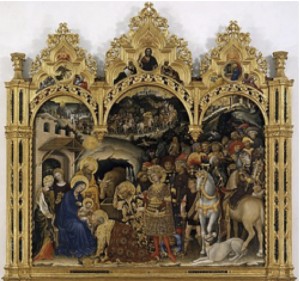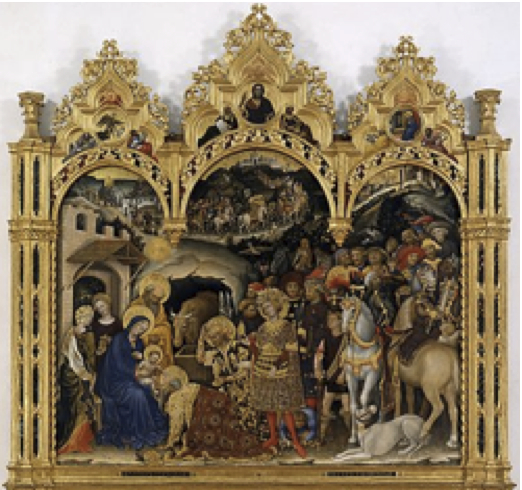Taking the “Christ” Out of Christmas

Celebrating the Holy Nativity of Jesus
A pdf copy to print is available via here.
“ Every male that opens the womb is to be considered holy to the lord.” Luke 2:22
The other day a bumper sticker caught my eye which read, “We still call it Christmas.” I took it to mean the annual plea by so-called true believers in the birth of a divine being in human form for us all to remember “the reasons for the season.” The orthodox Christian doctrine of the incarnation (lit. “in the flesh”) is the annual observance of Jesus’ birth being one and the same as a godhead taking human form in a cultic (that is culture-shaped) celebration generically referred to as “Christ’s Mass.”
The challenge for a progressive Christian who has moved beyond such notions as virgin births and gods disguised in human form come to save us from ourselves is to remember that it is as much a historical development, as it is a theological one. That is, the attribution of a “Christ” title accorded a very human Jesus constitutes the imaginations — if not machinations — of an early Church; consisting of very human, second-generation followers of a 1st century Galilean peasant sage and itinerant preacher. And who all but drowned out the authentic voice of the one who was once born and dwelt among humankind.
Such an assertion is simply based on the fact the historical Jesus never self-identified as the “anointed one,” the Christ.
As such, if one were to remove the Christ-title from the various birth narratives of those secondary traditions of this religious movement, what would remain of the “Christmas story” that has become as prevalently assumed, as it has been unexamined? If we took the Christ out of Christmas, what might remain of that still, small voice?
In a prior commentary I suggested what an open-ended “creed” might look like for one who has moved beyond the encumbrances of a fixed set of beliefs one no longer finds credible; and consider instead how one might still act in a world that is so clearly at odds with what many scholars and lay explorers have discerned to be the core teachings of a very human Jesus. To do so, however, requires us to use as our only roadmap the very texts that include some of those very nativity dramas reenacted each year; generically referred to as the happy holiday season of peace and goodwill to all.
First, let’s remember that the earliest writings we have about Jesus – an anonymous collection from which the synoptic gospels drew source material – contain no birth narrative. Of the four canonical gospels, the earliest one (Mark) has no story about Jesus’ birth either; while the latest written gospel in our New Testament canon only has the highly stylized logos poem of incarnation, about the co-eternal Word that “became flesh and dwelt among us.” (John 1:14) Only Matthew (1:18-25) and Luke (2:1-22) give us two different tales about the birth of Jesus, from two different theological retrospectives. By far the more elaborate and fanciful of the two is Luke; without which our children’s pageants would be a rather sparse one-act drama with a very small cast.
The contemporary scholar/writer, Jack Spong, suggests the familiar Lucan birth narrative be understood as an allegory; an extended metaphor, where all the characters in the magical tale symbolically represent someone else, or something else. As such, the enduring power of this story lies in the fact it is our human story; which we ought reenact for our own benefit, if only we have eyes to see and ears to hear. Without fail each holiday season, contemporary variations of an ancient, universal story can be found.
The enduring power of this story lies in the fact it is our human story. Without fail each holiday season, contemporary variations of the ancient, universal story can be found.
Recently, a Canadian couple were vacationing in Hawaii. Because she was six months pregnant and their universal health care system was not actually universal, they took the necessary precautions. The mother-to-be got the doctor’s permission to travel, and purchased medical insurance for the period of time they would be in another country.
But when Jennifer’s water broke and the baby was born nine weeks early, hospitalization and extensive medical treatments in intensive care for the newborn resulted in the delivery of a $950,000 bill, along with the new kid. Blue Cross denied coverage, claiming there was a “pre-existing condition.”
“Who can pay a million-dollar medical bill? Who can afford that?” asked the new mother. “It makes you sick to your stomach.”
At first, the plotline sounds reminiscent of an old familiar story: “Everybody had to travel … Mary was pregnant. It so happened while they were there the time came for her to give birth, and she gave birth to her first born …” (Luke 2)
What should they do next? Another variation of the old story suggests, “Get up, take the child and his mother, and flee …!” (Mt. 2:13)
Not to make light of the murderous treachery of Herod’s tale in Matthew’s gospel, it too sounds all too familiar. The recent memory of Newtown is hardly a year old, while this holiday season the news from Islamabad, Pakistan brings us the story of the massacre of 130 innocents, mostly school children.
With or without the birth narratives in the canonical gospels, the core messages of Jesus’ teachings begin to emerge from wherever the gospel writers and their early faith communities pick up the trail. The Christmas “allegories” merely give birth to a movement inspired by the Galilean sage’s message.
With or without the birth narratives in the canonical gospels, the core messages of Jesus’ teachings begin to emerge from wherever the gospel writers and their early faith communities pick up the trail. The Christmas “allegories” merely give birth to a movement inspired by that message.
Only a few weeks ago, the latest uproar over the latest chapter in the ongoing debate over immigration reform — intended to deal with our neighbors on the other side of our southern border — seemed to get replaced by the “don’t shoot,” and “I can’t breathe” protest demonstrations in our own city’s neighborhoods; where the mere question of a latent form of racism that seems to have been our historical curse and inheritance as a nation from its inception has once again demanded our attention as a society.
We turn to the wizardry of modern technology and our law-and-order mantra, thinking stronger border security and body cameras on every law enforcement officer will save us from the worst in us. But all the while, who is asking the question the rich young man looking to justify his own behavior once asked the Galilean teacher, “Who is my neighbor?”
The same question might just as well be asked in the context of another recent controversy, looking just 90 miles off our Florida coastline. How many times could we re-tell the story of inverted logic of a gospel message when it comes to the notion of a good Samaritan?
If that isn’t outrageous enough, consider the teachings – modeled for us by Jesus’ own way of life – about turning the other cheek, and loving one’s enemies. Then consider whether arguing over whether or not EIT’s (“enhanced interrogation techniques”) constitute torture isn’t a bit ludicrous; the distinction based solely on the legality of whether such behavior was authorized by superiors, and the expediency of necessity to inflict such harm on another human being to potentially save ourselves from further harm.
Then there’s the recent incident that would be almost laughable, if it wasn’t so serious. An entertainment industry giant kowtows to cyber-threat hacksters; who embarrass them by exposing their own secrets in public, while presumably threatening our collective first-amendment free speech rights and artistic free expression. Why? Because these so-called cyber-terrorists’ object to the release of a slapstick comedic satire that portrays blowing the head off a real-life tyrannical leader of a repressive regime.
Sony Pictures initially pulled the release of the film when major theater chains declined to screen it, citing practical safety and liability concerns. The distributor later announced The Interview would, in fact, be shown after all in a few select theaters starting Christmas Day. But if you can’t catch it in your locale, Warner Brother’s has its own holiday release, American Sniper. It’s the biographical drama of a Navy SEAL, who earned the nickname, “Legend,” because he dealt such a lethal blow against the enemy they put a bounty on his head.
In all the heated debate, however, I’ve yet to hear anyone mention the seeming irony of such films being released on the annual observance of what a vast number of religious types regard as the birth of a Jewish messiah; who was presumably a legend in his own right. Though there was a bounty on his head, he was given the title in fulfillment of an ancient prophecy as our “mighty Counselor … the Prince of Peace.” (Is. 9:6)
The kinds of stories that surround the gospel myth of Jesus’ nativity that get reenacted over and over again are about as real as it gets. Consequently, we look at the Christmas story again and again. But where is the “Christ” in Christmas? If one considers the angelic announcement in Luke’s fable about Jesus’ birth ushering in “peace on earth, goodwill to all” to be nothing more than innocent naiveté, what should we do with the Christmas story?
Luke follows his allegorical Christmas story with the his description of the purification rite every faithful Jewish parent would have undertaken with their new child: Now when the time came for their purification according to the Law of Moses, they brought him up to Jerusalem to present him to the Lord – as it is written in the Law of the Lord, “ Every male that opens the womb is to be considered holy to the lord.” (Luke 2:22)
For a progressive who has moved on from attaching any singular divinity to a human Jesus — but who may still regard the birth of every human being as a holy and sacred thing — it seems apparent the Christ title needs to be either genuinely embraced, redefined, or left behind.
Redefining a Christology is more than simply an intellectual exercise. It calls us to redefine what it means to regard a human Jesus as “an anointed one;” to be designated, lifted up and regarded as the expression of those holy and eternal truths that are applicable in every age. And that includes the refutation of what is generally accepted as “just the way things are.”
© 2014 by John William Bennison, Rel.D. All rights reserved.
This article should only be used or reproduced with proper credit.
To read more commentaries by John Bennison from the perspective of a Christian progressive go to

